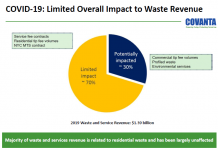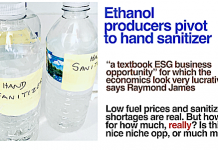Besides a slew of clean car announcements connected to the North American International Auto Show, the alt energy topic that has made media and blog headlines most often over the past week has been alternative fuels. We are thus going to run a 2-part series on alternative fuels this week as follows: ethanol today and coal-to-liquids tomorrow. ETHANOL: INVESTOR FRIEND OR FOE? I’m going to start this post with a statement of opinion: I don’t really like corn-based ethanol (as an investment), I never have, and, as a result, I haven’t followed this space as closely as I probably should have. AltEnergyStocks.com Contributing Editor Neil Dikeman, in a November post, did a great job of outlining key concerns investors should have with ethanol as an asset class. However, whether one likes ethanol or not, it was without a doubt one of the top alt energy stories of 2006, and will remain a biggie in the years ahead. Industry Growth: Some Numbers Ethanol is an interesting beast because, from one point-of-view, it’s merely the new-kid-on-the-block of a decades-long US agricultural policy. Let’s face the facts: US farmers are not, without massive subsidies and trade protection, competitive on a global basis. In a free global market, nobody would want US crops because they’re plain too expensive. Luckily, with the help of US tax-payers, the US farm industry has been able to survive, and, in many cases, thrive. But the US agricultural complex has, in the past few years, come under increasingly intense pressure from America’s trading partners, and cracks in the system are unavoidably beginning to show. Ethanol provides a partial route out of these troubles; redirect the expensive corn away from international markets to US-based ethanol processing facilities, put in place the right regulatory framework to boost ethanol demand, and keep the low-cost ethanol producers like Brazil at bay with tariffs. The result? A booming ethanol industry that is fundamentally transforming the economics of corn farming in the US. Consider this quote from a recent Bloomberg article on biofuel demand and feedstock prices: “The 110 factories now producing ethanol in the U.S. have boosted their annual capacity by 12 percent in the past six months, to 5.3 billion gallons, according to the Renewable Fuels Association in Washington. An additional 6 billion gallons of capacity will be added in the next two years as 79 new plants or expansions of factories are completed, the association said.��? The industry’s capacity will thus grow by 113% by the end of 2008, a significant number. And then there are those who are disputing these growth forecasts, saying they are gross underestimates. Lester Brown, a known environmental commentator, argues that the Department of Agriculture’s projections that ethanol producers will, as a result of industry growth, consume 60 million tons of corn by 2008 are wrong, and says he instead expects ethanol manufacturers to consume 139 million tons of corn by then, more than double (by the way, the Earth Policy Institute, Lester Brown’s outfit, produced this very cool table of ethanol distilleries in the US by aggregating data from multiple industry sources. I don’t know of any other such resource). However way you look at it, if the ethanol industry is truly responsible for the current rise in corn demand and associated run in corn prices, it is doubtful US farmers will be able to scale up production enough to keep pace with the kind of refining capacity growth discussed above, and prices should thus spike. The result of this will be that the food-Vs-fuel debate, which was mostly academic only 18 months ago, will intensify, pitting farmers and the ethanol industry against environmentalists and other concerned citizens. Another impact of this will be that high feedstock costs will eat away at producers’ margins, as there will be limits to what the market will tolerate in terms of price increases, especially if oil gets cheaper. Ethanol: The Politicians’ Favorite Kid There are early signs that the new Democratic Congress wants to forge ahead with the budding ethanol economy. This article from the Green Car Congress provides details on a proposed piece of legislation that, if adopted, would grant significantly more regulatory certainty to the ethanol industry than to just about any other alternative energy industry in America. A nation-wide renewable fuel standard with a 2030 timeframe is something the wind and solar industries could only ever dream of, and this despite the growing controversy surrounding corn-based ethanol. Besides the concerns outlined above, there also remains the fundamental question of whether or not, on balance, more energy is required to bring a unit of ethanol to market than that unit yields once consumed. A recent MIT study does not provide a conclusive answer to that question. It has become clear that, among alternative energy sources, ethanol is the political favorite. Like the parent who, for one reason or another, loves a kid more than its siblings, Federal legislators have embraced ethanol, and are giving it visibly more motherly love than its available sister solutions, namely tougher fuel efficiency standards and plug-in hybrid technology. But politicians shouldn’t kid themselves; ethanol, it seems, is not the win-win solution to air pollution, climate change, foreign oil dependence and a dying farming sector that some had hoped. Something tells me that a battle is now brewing, and an anti-ethanol lobby, or at least a put-a-moratorium-on-further-ethanol-growth lobby, could emerge sooner rather than later. Investing in Ethanol: All is not Lost I’m not suggesting investors steer clear of ethanol altogether here; I’m merely pointing out that, while some people are hailing the growth in the ethanol industry as the next Klondike, there are some very significant and immediate concerns with corn-based ethanol that will have to be addressed. These concerns could, under a bearish scenario, stunt growth in the sector, or at least threaten the profitability of more vulnerable players. But all is not lost. In my view, corn-based ethanol is one of those transition technologies that will play a key part in America’s energy mix for some time, but that will slowly dwindle into irrelevance as better solutions come on-stream. The best plays on ethanol should therefore do well, for a time. While I’m not familiar enough with any of the top ethanol pure-plays to make an authoritative call, certain larger companies have certainly benefited from the ethanol boon so far. ADM
[NYSE:ADM], Monsanto [NYSE:MON], and Syngenta [NYSE:SYT] are all names that come to mind. Seeking Alpha’s Ethanol section is a good resource for the would-be ethanol investor. You should also keep an eye on firms that are working on cellulosic ethanol. Cellulosic ethanol holds great promises, as evidenced by the fact that Goldman Sachs took, in May 2006, a $30 million position in cellulosic ethanol firm Iogen of Canada. But cellulosic ethanol is at least 5 years away. In short, I’m sure ethanol, as an asset class, can and will make you money. The ethanol investor will, however, have to be cautious, as the waters ahead are not free of trouble. (DISCLOSURE: I do not have positions in any of the stocks discussed in this article)








